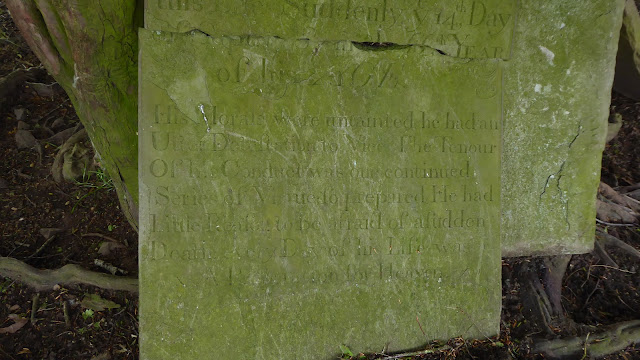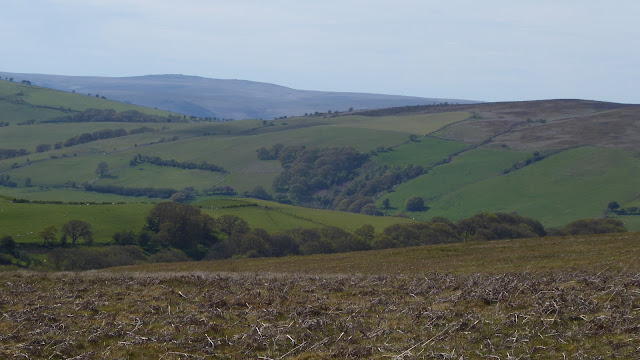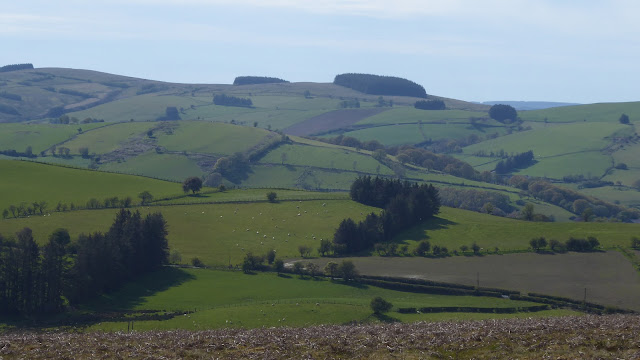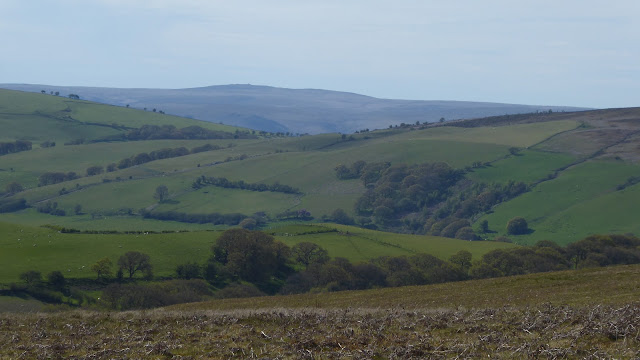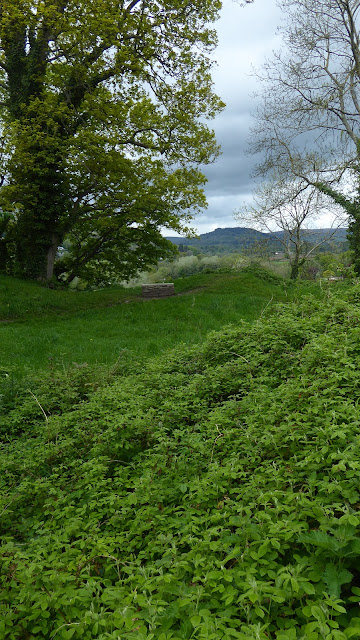Tam and I have been intrigued by this roadside sign as we head towards Brecon on the old road (it was the Turnpike road apparently). Thursday was a lovely sunny day, and before tea we decided to head out to check out the site of this church.
We crossed a field of sheep, with a dewpond from all the recent rain (only one day without rain in the entire month!) and crossed a little stream. On the left was a pile of rubble, which we thought looked like it might be stone from the demolished church. This was on our right, with quite a lot of tree growing up through the walls, but it was TINY. The rendered walls had lines drawn on them to suggest stonework. We decided this couldn't possibly have been it, but was perhaps a tiny Sunday School back in the day?
Beyond the rubble was a circular graveyard wall, made of dressed stone. We headed towards it past the rubble - obvious huge stone flags there and old oak beams.
The graveyard was still a place of death - a fairly recently-deceased sheep . . . Nearby was a dead Magpie (that's a first for me to see).
The original Church dated from the late medieval or late 18th C using local stone and a slate roof. was rebuilt in 1882 and is described on one site as "an ancient, mean edifice, possessing no claim to architectural notice . . . in a very bleak situation . . . It is a remarkably small church, measuring only thirty-one feet and a half by seventeen feet." (I would credit this if I hadn't just copied and pasted bits from half a dozen different sites, Genuki included). This alter was built after the church was demolished in 1964, although it was closed for divine service in 1916 and finally deconsecrated in 1963.
There were a few gravestones still remaining in situ, but not many - others were propped up or laid flat. Poor Phillip Pitchford either died aged 14 years or 1 1/4 years.
Propped up against the single (old) Yew tree in the graveyard was the Vicar's own gravestone. Sadly the year of his death does not appear to have survived and I have had no success in trying to find out more about him (though I spent a happy afternoon trying!) It reads: Here lieth the Body of the Rev. Thomas Davies, the Minister of Gwenddwr, Alltmaur, Llangunten and Llangynog and who departed this life Suddenly ye 14th Day of September ????? in the 66th Year of his AGE. I imagine from the use of "ye" it was the late 1700s, early 1800s. Blowing it up I can possibly make out 1 7 ? possibly 8?
Either his parishioners or his family thought a lot of him as there is a long (expensive!) verse on the bottom half of the stone.
His Morals were untainted he had an Utter Detestation to Vice. The Tenour
Of his Conduct was one continued
Series of Virtue so prepared. He had
Little reason to be afraid of a sudden
Death every day of his Life was
A preparation for Heaven.
The long "s" was used in this headstone, but was out of fashion by the 18thC and stopped being used in printed texts in 1782, so it would appear that Thomas Davies was extant in the 18th C. (Further investigation whilst photos loading - noticed I had his dad's headstone too -
In Memory of David Davies, late of this parish, Gent. He died ye 11th June 1801 aged 84 years. So he was born in 1717 and I found him born in Carmarthen, where he was also married to a Mary Howell on 20/11/1742. They had only one child, a son Thomas, born in 1743. Which would put Thomas's death in 1809. It would appear that the long S stayed around a lot longer in rural Welsh areas . . .
I did some census lookups on Ancestry, and found a farmer Thomas Davies (Minister too perchance?) living at Pengarreg, and amongst the people under his roof were David James, Boarder, Unmarried, 57, Pauper, b. Llanafan. Note in margin: Blind from Smallpox from 14 years of age. Poor soul. Pleased that he was taken in and cared for.
Ann, wife of David Phillips, died 1801 aged 37 years.
Love the address - Harp Cottage, but it no longer exists on the map, sadly. I've looked up John Bevan, and he was a wheelwright.
The Yew tree was pretty ancient and still regenerating . . .
Oh, lastly (and I could go on and on here), the little wee church was dedicated to St Cynog, one of Brychan's fruitful loins. He had an interesting life, and can be read about HERE.
Even Gerald of Wales knew of him: "Moreover I must not be silent concerning the collar which they call St. Canauc's; for it is most like to gold in weight, nature, and colour; it is in four pieces wrought round, joined together artificially, and clefted as it were in the middle, with a dog's head, the teeth standing outward; it is esteemed by the inhabitants so powerful a relic, that no man dares swear falsely when it is laid before him it bears the marks of some severe blows, as if made with an iron hammer; for a certain man, as is is said, endeavouring to break the collar for the sake of the gold, experienced the divine vengeance, was deprived of his eyesight, and lingered the remainder of his days in darkness." (From Wikipedia on Gerald of Wales: St Cynog.)
So, amazingly, for a heap of rubble, a scarcely remembered extinct church, and a couple of gravestones, we have an intriguing bit of Welsh social history and a Saint who made quite an impression . . .







